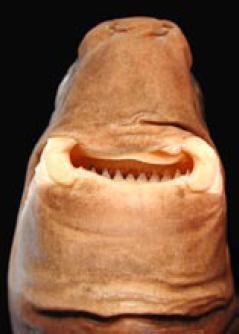Cookie-Cutter Shark Takes First Bite of Human Flesh

For one swimmer, a late night dip ended in a painful altercation with a cookie-cutter shark, the first documented case of the small shark nipping at a living human. But why did it happen?
The attack occurred in the waters between Hawaii and Maui on March 16, 2009, as the victim was attempting to cross the Alenuihaha Channel. The long-distance swimmer was making the 30-mile (48 kilometers) trek across the channel at sunset when he felt the shark take a bite out of his chest, then his left calf as he left the water. The sharks usually attack other sea animals, such as fish and whales, and feed mainly at night. Because of this, they don't often encounter day swimmers. They live in open ocean tropical waters, like those off of Hawaii. As beach weather begins, nighttime tropical ocean swimmers should be aware of their possible presence and take precautions.
"Not only is it painful, but it presents a difficult circumstance for recovery in the sense that there has to be plastic surgery to close the wound and you have permanent tissue loss," study researcher George Burgess, of the University of Florida's Florida Museum of Natural History, said in a statement.
Scoop of flesh

The cookie-cutter shark grows to about 2 feet long as an adult, but have specially crafted jaws that can scoop out a nugget of flesh, leaving a gaping hole, hence the "cookie-cutter" name. Their bites aren't lethal, but the bites leave obvious markings, even after they've healed. [On the Brink: A Gallery of Wild Sharks]
"It's not as scary as 'Jaws,' but it's very different from any other kind of attack we have in the International Shark Attack File because of the size of the shark and the modus operandi," Burgess said.
While many people fear great white sharks thanks to "Jaws" tiger sharks are among the deadliest sea creatures, and they kill more people than any other shark. However, shark attacks are rare. The number of people attacked by sharks globally each year is about equal to the number of people killed by lightning in the United States.
Sign up for the Live Science daily newsletter now
Get the world’s most fascinating discoveries delivered straight to your inbox.
Laying in wait
The sharks attack larger animals because they have an interesting camouflage mechanism: Glowing markings on their skin let them hide in groups of squid, which also glow. When larger animals feed on the squid, the shark can launch a surprise attack on their victim and quickly leave the scene after nabbing a chunk of flesh.

"They have the biggest teeth of any shark in relation to the size of their jaws," Burgess said. "They look like the cartoon sharks you see with oversized teeth."
Because the sharks are small, cookie-cutter shark bites aren't that powerful; because of this, skin-scooping shark bites can probably be avoided by wearing a thick wetsuit when swimming in the open ocean at night, John O'Sullivan of the Monterey Bay Aquarium, said in a statement.
"These animals are very small and very aggressive in behavior. People say, 'Thank God these things don't get big,'" O'Sullivan said. The details of the attack have been published this week in the journal Pacific Science.
You can follow LiveScience staff writer Jennifer Welsh on Twitter @microbelover. Follow LiveScience for the latest in science news and discoveries on Twitter @livescience and on Facebook.
Jennifer Welsh is a Connecticut-based science writer and editor and a regular contributor to Live Science. She also has several years of bench work in cancer research and anti-viral drug discovery under her belt. She has previously written for Science News, VerywellHealth, The Scientist, Discover Magazine, WIRED Science, and Business Insider.











